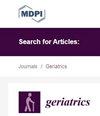The Contributions of Knee Extension Strength and Hand Grip Strength to Factors Relevant to Physical Frailty: The Tanno-Sobetsu Study
IF 2.1
Q3 GERIATRICS & GERONTOLOGY
引用次数: 0
Abstract
Sarcopenia is the core factor of frailty. This study specifically focused on lower limb muscle strength and examined muscle indices that indicate the risk of frailty or pre-frailty in older adults. The study included 327 community-dwelling individuals aged ≥65 years (43.7% male) who participated in the cohort. Frailty was defined based on five symptoms: weight loss, low activity level, exhaustion, weakness and slowness. Participants were classified into frail (three or more applicable), pre-frail (one to two applicable) and non-frail groups. Muscle strength (knee extension strength, toe grip strength and hand grip strength) were assessed, and appendicular muscle mass was assessed via a bioelectrical impedance analysis. The adjusted odds ratio (OR) of muscle indices for with frailty (frail group vs. pre-frail group) or pre-frailty (pre-frail group vs. non-frail group) were calculated. The prevalence of frail and pre-frail was 7% and 40%, respectively. Adjusted for age, sex, albumin and medical history, knee extension strength was significantly associated with frailty (odds ratio 0.95, 95% CI 0.92–0.98), while hand grip strength was associated with pre-frailty (odds ratio 0.92, 95% CI 0.88–0.97) but not with other muscle indices. This study is significant for identifying knee extension strength as a factor relevant to frailty in older adults considered pre-frailty, emphasizing the importance of this specific muscle measure in predicting and managing frailty.膝关节伸展力量和手部握力对身体虚弱相关因素的影响:丹野宗别研究
肌肉疏松症是导致虚弱的核心因素。本研究特别关注下肢肌肉力量,并检查了表明老年人虚弱或虚弱前期风险的肌肉指数。研究对象包括 327 名年龄≥65 岁的社区居民(43.7% 为男性)。虚弱的定义基于五种症状:体重减轻、活动量少、疲惫、虚弱和行动迟缓。参与者被分为虚弱组(三种或三种以上症状)、前期虚弱组(一至两种症状)和非虚弱组。对肌肉力量(膝关节伸展力量、脚趾握力和手部握力)进行了评估,并通过生物电阻抗分析对附属肌肉质量进行了评估。计算了体弱组(体弱组与体弱前组)或体弱前组(体弱前组与非体弱组)肌肉指数的调整后几率比(OR)。体弱组和前期体弱组的发病率分别为 7% 和 40%。经年龄、性别、白蛋白和病史调整后,膝关节伸展力量与体弱显著相关(几率比 0.95,95% CI 0.92-0.98),而手部握力与体弱前期相关(几率比 0.92,95% CI 0.88-0.97),但与其他肌肉指数无关。这项研究的重要意义在于将膝关节伸展力量确定为与被认为是虚弱前期的老年人的虚弱相关的一个因素,强调了这一特定肌肉指标在预测和管理虚弱方面的重要性。
本文章由计算机程序翻译,如有差异,请以英文原文为准。
求助全文
约1分钟内获得全文
求助全文
来源期刊

Geriatrics
医学-老年医学
CiteScore
3.30
自引率
0.00%
发文量
115
审稿时长
20.03 days
期刊介绍:
• Geriatric biology
• Geriatric health services research
• Geriatric medicine research
• Geriatric neurology, stroke, cognition and oncology
• Geriatric surgery
• Geriatric physical functioning, physical health and activity
• Geriatric psychiatry and psychology
• Geriatric nutrition
• Geriatric epidemiology
• Geriatric rehabilitation
 求助内容:
求助内容: 应助结果提醒方式:
应助结果提醒方式:


